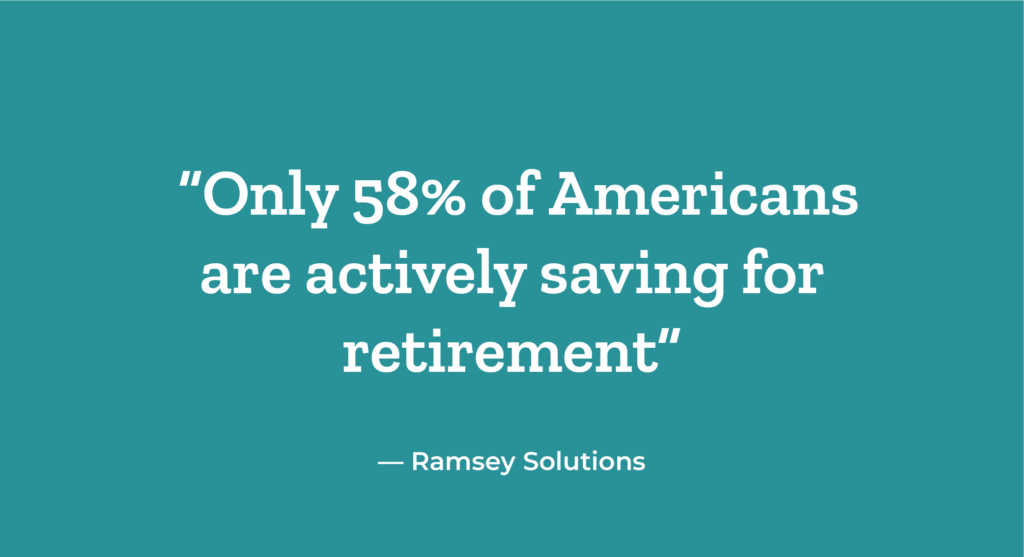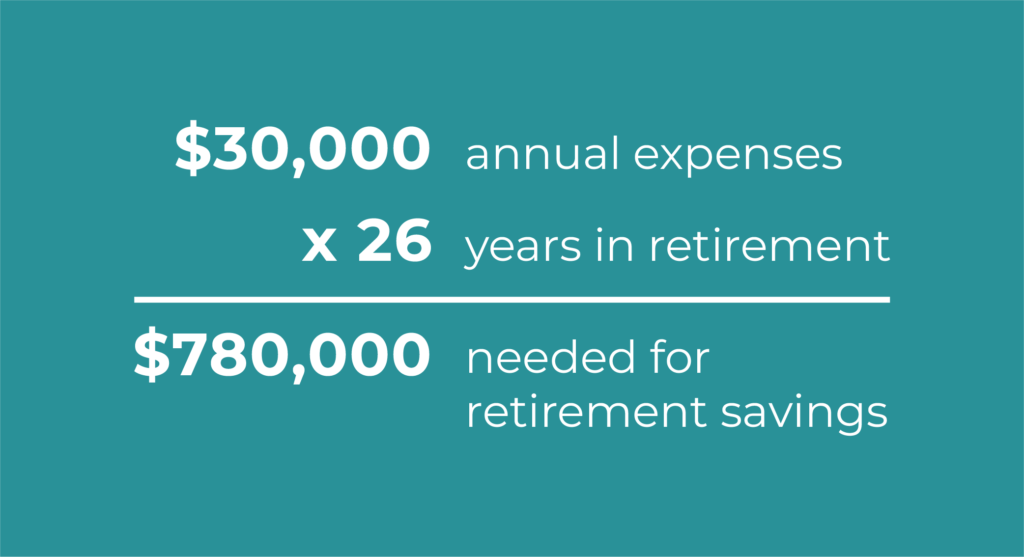By Wenqi Huang, Brighton Jones, and Obioha Okereke, College Money Habits
We all dream of retiring from our jobs some day. Whether it is to spend more time with family, relocate to a new state, travel or pursue hobbies, retirement is something that many of us look forward to.
However, a significant amount of Americans are not saving or planning for retirement. Why is this? Well, there can be many reasons. Paying off student loans, emergency expenses or other debt, or the rising cost of living are just some of the challenges that can make it difficult to save toward retirement.
Why is planning for retirement important?
Having a flexible plan for retirement can help you prepare to reach your goals, whether you’re just starting saving or getting close to retirement. Many people are living longer, which means retirement can last a lot longer than imagined. Social security benefits are generally not enough to support the lifestyle you are used to while working or would like to have in retirement. The average Social Security check in 2020 is about $1,500.
For peace of mind, it is crucial to create a plan so that when retirement comes, you won’t be left wondering if you have enough funds to afford your living expenses. Taking steps to create a retirement plan is an important part of financial wellness, as well as benefits your physical and emotional health.
Planning ahead can also help you avoid major taxes upon retirement that eat into your income and savings. Plus, having a big-picture context of retirement can guide career and financial decisions throughout your life.
How does one start to plan for retirement?
Retirement does not look the same for everyone. For instance, someone planning on retiring to manage a farm will require a different retirement savings than someone who wants to pay off their mortgage, purchase a lakefront property and enjoy traveling several times a year. Ask yourself, “What lifestyle would I like to enjoy during my retirement?”
Consider your aspirations for retirement.
Planning for retirement can be overwhelming so don’t be afraid to take it slow and do your research. A few of the factors to think about in planning for retirement are:
- What is your annual cost of living?
- Will others be depending on your income?
- What are your goals?
- Do you plan on traveling frequently?
- Do you want to purchase a larger home?
- Do you want to purchase your dream car?
Understand your retirement savings needs.
Two of the most important variables in calculating your retirement savings needs are your expected annual retirement expenses and retirement age. For example, if you’d like to spend more in retirement, you will need more in savings, and if you would like to retire earlier, you’d have to save more in a shorter period of time.
Tip: Think of what age you’d like to retire and how much money you might need annually to cover your living expenses and enjoy your desired lifestyle. Then, multiply that amount by the number of years you expect to be retired. This will get you to a baseline of your retirement savings needs.
For example, let’s say you are a woman hoping to retire at the age of 55 and you expect your annual expenses to be $30,000. Women tend to live longer than men and the average life expectancy for a woman is about 81 years. Using this statistic, this would mean you would be retired for a total of 26 years. During those 26 years, you will want to make sure you have enough savings to support your desired lifestyle.
To make sure you have enough savings, you could calculate your baseline by doing the following:
If your calculation seems unrealistic with your current income and financial situation, you may want to look for ways to increase your earnings or ramp up your savings and/or investments. Or, you may need to adjust your expectations for retirement, such as working longer or retiring on less savings.
There are also many retirement calculators available online that factor in different variables and provide an estimate of: 1) how much you need in total upon retirement; and 2) how much you should save monthly to reach that total.
Curious to know how much you need for retirement? Check out Retirement Calculator by Smartasset.
Friendly reminder: Don’t let the calculator’s total retirement need intimidate you! This is not the amount you need to save dollar for dollar. The calculator is solving for a need that’s decades down the line, and it’s taking into account assumptions for inflation and expected investment returns. The best way to use a retirement calculator like this is by looking at the monthly target to help with your own goal setting. If the monthly target still doesn’t seem achievable, try playing with the numbers to see what happens if you spend less or work longer.
Life isn’t linear. Some months you might be below target and other months you might be above. Your income may increase over time. If you are raising a family, your kids may move out of the house and you can save more. Life changes like these cannot be accounted for with a simple calculator.
Know your retirement plan options.
Retirement plans allow you to save for the future. There are plans for employees, for business owners or people who are self-employed, and some are available to everyone. Retirement plans vary by when you pay income tax, contribution limits and withdrawal rules. Following are some common types.
401(k): If you are a part-time or full-time employee, your employer’s 401(k) plan can be a convenient way to regularly divert a portion of your pre-tax income toward a retirement investment account. Your contribution lowers your taxable income, so if you earn $55,000 in one year and put $5,000 into your 401(k), your taxable income is only $50,000. The money grows tax-free until you choose to withdraw it, at which time you pay income tax. You have to be at least 59 ½ to take out money without penalty, and you must start withdrawing money at age 72.
The major advantage is that many employers will match your contributions, increasing the total amount you invest. A general rule of thumb is to contribute at least the minimum to receive the full employer match. If you can contribute more, the 2022 contribution limit is $20,500 for individuals under the age of 50. And, if you are 50 or older, you are allowed an additional $6,500 for a total contribution of $27,000.
To learn more about 401(k) matches, check out How Does 401k Matching Work? by Investopedia.
Traditional and Roth IRAs: IRA stands for “Individual Retirement Arrangement.” Anyone can set up an IRA. Traditional IRAs are similar to 401(k) plans in the way tax advantages work. Your contributions are pre-tax, reducing your taxable income. And, the money grows tax-free until you withdraw it.
Roth IRAs work the opposite. Contributions are post-tax, meaning you pay taxes on the money you put into your Roth IRA account, but you can withdraw tax-free at retirement. Also, with Roth IRAs you don’t have to start withdrawing money at age 72, and you can withdraw some money early without penalties.
For IRAs, the contribution limits are much lower. In 2022, individuals are eligible to contribute up to $6,000, or $7,000 if over age 50.
SEP and Simple IRAs: SEP stands for “Simplified Employee Pension,” and is used by self-employed people or small business owners. A SEP IRA tends to operate similarly to a traditional IRA, but the contribution limits are much higher. If you are self-employed, you can contribute up to 25% of your net income, and employers can similarly contribute up to 25% of an employee’s income.
A Simple IRA is a “Savings Incentive Match Plan for Employees” for small businesses with 100 or fewer employees. Employers must either match employee contributions up to 3% of the employee’s salary or contribute 2% of the employee’s salary regardless of the employee’s contribution. In 2022, employees can contribute up to $14,000 from their salary, or $17,000 if they are over age 50.
Consider real estate as part of your retirement investment.
Real estate could be part of the consideration as well, and just as with anything, there will be questions to think through to see if it is the best vehicle for you to consider as a retirement plan.
A few preliminary things to note:
- Real estate is less flexible, and your ownership equity is harder to access as cash
- If you are planning on your primary residence appreciating in value and selling it at retirement, what are your plans to live somewhere else? Will you have enough funds left over to live on for the rest of your life in combination with your other assets?
- If you are considering rental properties, after all expenses (mortgage, taxes, insurance, maintenance), will you be able to capture earnings with your rental income? How long would you want to hold on to the property?
Purchasing real estate is a great long-term strategy for building wealth. Historically, the price of real estate has risen and given that it is an asset you own, it is something you can sell if you would like to raise cash. Moreover, if you purchase real estate to rent out, you can earn passive monthly income, which will allow you to regularly earn money without much manual effort.
A few final thoughts
Start early. Even if you don’t have a large amount set aside right now, compounding interest will help you in the long run. Calculate your discretionary income to figure out how much you can comfortably save or invest each month and then create a habit of regularly setting aside money in your retirement fund. Automating your savings and investments can help make this process easier!
The earlier you start, the better. Whether you are saving through a high-yield savings account or an investment account (or both), your money will grow over time. As long as you stay consistent and don’t withdraw money from your retirement savings, you will experience very steady growth that might even surprise you. The later you start, the less time your money has to compound and to achieve your goals, you might be required to set aside a larger sum of money each month to make up for the time that was lost.
That said, if you’re late to planning for retirement, there is still time and methods to help you boost your savings! Start by estimating out how much money you’ll need in retirement and considering taking advantage of catch-up contributions through 401k and Roth IRA investment accounts.
Balance short-term goals, such as buying a car, a house, paying off debts, with long-term goals as you plan for retirement. High-yield savings accounts allow you to create savings “buckets,” which enable you to set individual savings goals for all of your objectives. If your monthly savings capacity is x, figure out a way to allocate to each different bucket that feels achievable. Make sure to consider any large purchases that will need to occur or other objectives you have. The more factors you can include in your plan, the more informed and realistic your plan will be.
Start investing! Invest your retirement accounts in well diversified mutual funds and let it ride out the market volatility. There will be times when the market is not doing well, and the account values drop. It is very difficult to time the markets, and many investors let their emotions drive their decisions to sell at market lows. Keep in mind that you may be decades away from retirement, and that time horizon is long enough for the market to recover and reach expected returns. As you get closer to retirement, evaluate your options to invest less in equity and more in safer assets such as bonds so that you can ensure your account holds its value for you to spend in retirement. A target date fund will do this for you automatically.
Automate retirement savings. To make saving for retirement easier, consider automating your savings and investments so that you are always putting money away for retirement. This is one of many ways you can work to avoid running out of money during retirement.
Maintain flexibility. It is important to note that a retirement plan is not meant to be stagnant. As circumstances change, either individually or as a family, your retirement plan will need to be evaluated and updated to reflect reality. Review your plan regularly and adjust it based on changes to your income, expenses or desired lifestyle.
If you have any questions regarding these personal finance resources and/or general questions about managing your personal finances, contact Obi Okereke from College Money Habits at learn@collegemoneyhabits.com.
Related Articles:
Four Ways to Boost Your Savings
Savings provide financial security and enable you to pursue your passions. Start on the path to financial freedom by adopting these four strategies to amass savings.
What Is An Emergency Fund?
An essential part of financial health is creating an emergency savings fund to tap for unanticipated expenses, like medical bills or job loss. Learn how to save for emergencies.
Setting Financial Goals
Understanding your values and your financial goals create a framework for financial health — helping you prioritize how you spend your money and stay accountable.
Blog | How Saving and Investing Impacted My Life
College Money Habits Founder Obioha Okereke shares three of the biggest money habits that changed his life.




